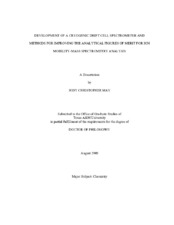| dc.contributor.advisor | Russell, David H. | |
| dc.creator | May, Jody C. | |
| dc.date.accessioned | 2010-10-12T22:31:26Z | |
| dc.date.accessioned | 2010-10-14T16:01:42Z | |
| dc.date.available | 2010-10-12T22:31:26Z | |
| dc.date.available | 2010-10-14T16:01:42Z | |
| dc.date.created | 2009-08 | |
| dc.date.issued | 2010-10-12 | |
| dc.date.submitted | August 2009 | |
| dc.identifier.uri | https://hdl.handle.net/1969.1/ETD-TAMU-2009-08-7022 | |
| dc.description.abstract | A cryogenic (325-80 K) ion mobility-mass spectrometer was designed and
constructed in order to improve the analytical figures-of-merit for the chemical analysis
of small mass analytes using ion mobility-mass spectrometry. The instrument
incorporates an electron ionization source, a quadrupole mass spectrometer, a uniform
field drift cell spectrometer encased in a cryogenic envelope, and an orthogonal
geometry time-of-flight mass spectrometer. The analytical benefits of low temperature
ion mobility are discussed in terms of enhanced separation ability, ion selectivity and
sensitivity. The distinction between resolving power and resolution for ion mobility is
also discussed. Detailed experimental designs and rationales are provided for each
instrument component. Tuning and calibration data and methods are also provided for
the technique.
Proof-of-concept experiments for an array of analytes including rare gases
(argon, krypton, xenon), hydrocarbons (acetone, ethylene glycol, methanol), and halides
(carbon tetrachloride) are provided in order to demonstrate the advantages and limitations of the instrument for obtaining analytically useful information. Trendline
partitioning of small analyte ions based on chemical composition is demonstrated as a
novel chemical analysis method. The utility of mobility-mass analysis for mass selected
ions is also demonstrated, particularly for probing the ion chemistry which occurs in the
drift tube for small mass ions.
As a final demonstration of the separation abilities of the instrument, the
electronic states of chromium and titanium (ground and excited) are separated with low
temperature. The transition metal electronic state separations demonstrated here are at
the highest resolution ever obtained for ion mobility methods. The electronic
conformational mass isomers of methanol (conventional and distonic) are also partially
separated at low temperature. Various drift gases (helium, neon, and argon) are explored
for the methanol system in order to probe stronger ion-neutral interaction potentials and
effectuate higher resolution separations of the two isomeric ions. Finally, two versatile
ion source designs and a method for axially focusing ions at low pressure (1-10 torr)
using electrostatic fields is presented along with some preliminary work on the ion
sources. | en |
| dc.format.mimetype | application/pdf | |
| dc.language.iso | en_US | |
| dc.subject | ion mobility-mass spectrometry | en |
| dc.subject | selected ion injection | en |
| dc.subject | cryogenic drift tube | en |
| dc.subject | helium, neon and argon drift gases | en |
| dc.subject | mass isomers | en |
| dc.subject | electronically excited states | en |
| dc.subject | mobility-mass correlation trendlines | en |
| dc.subject | temperature dependant ion selectivity | en |
| dc.title | Development of A Cryogenic Drift Cell Spectrometer and Methods for Improving the Analytical Figures of Merit for Ion Mobility-Mass Spectrometry Analysis | en |
| dc.type | Book | en |
| dc.type | Thesis | en |
| thesis.degree.department | Chemistry | en |
| thesis.degree.discipline | Chemistry | en |
| thesis.degree.grantor | Texas A&M University | en |
| thesis.degree.name | Doctor of Philosophy | en |
| thesis.degree.level | Doctoral | en |
| dc.contributor.committeeMember | North, Simon W. | |
| dc.contributor.committeeMember | Lucchese, Robert R. | |
| dc.contributor.committeeMember | Church, David A. | |
| dc.type.genre | Electronic Dissertation | en |
| dc.type.material | text | en |


